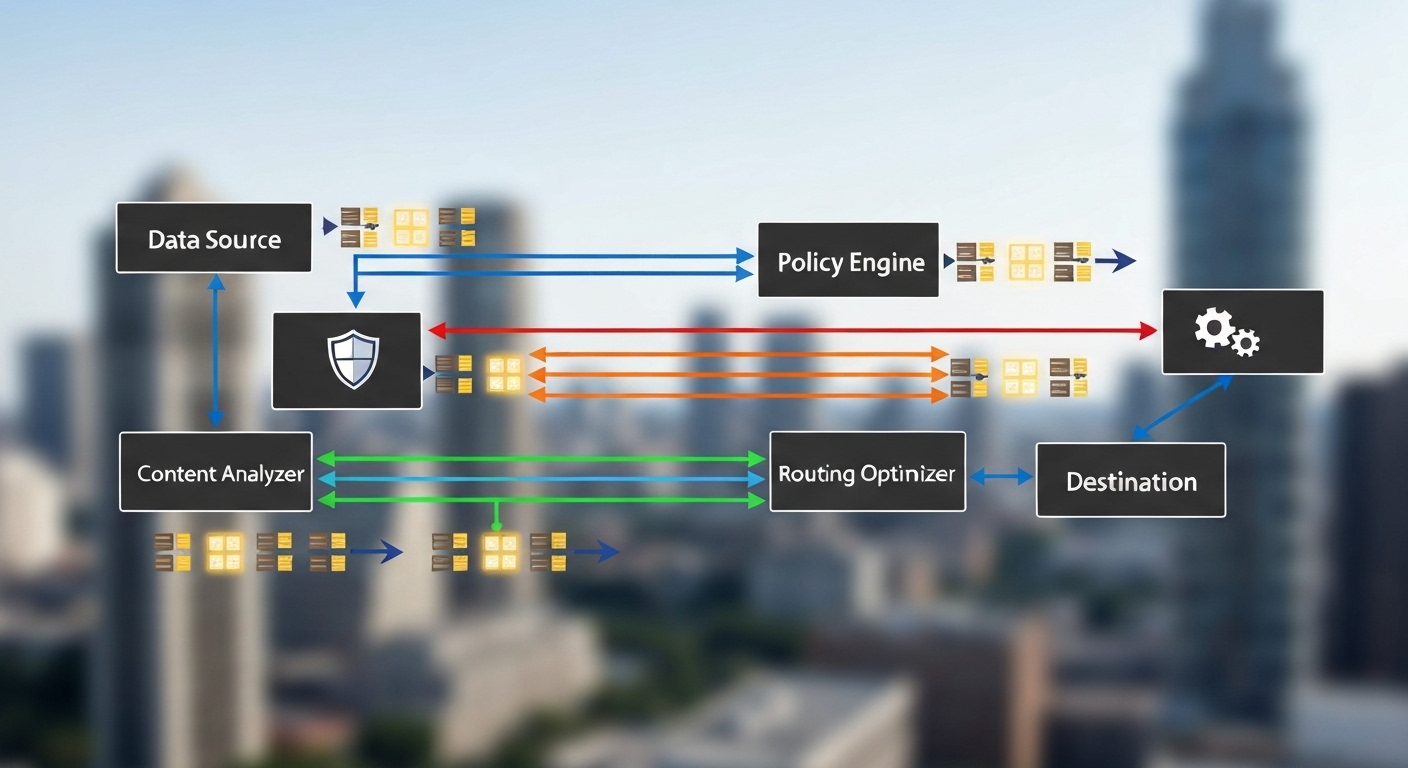Intelligent Data Routing and Processing : Optimizing Data Workflows
Intelligent data routing and processing is the cornerstone of modern data management, enabling organizations to efficiently handle the ever-increasing volume and velocity of data. It involves strategically directing data to the appropriate processing engines, ensuring timely and accurate insights, and optimizing overall data workflows.

Understanding the Basics of Data Routing
Data routing is the process of determining the optimal path for data to travel from its source to its destination. In traditional systems, this routing was often static and pre-defined. However, intelligent data routing leverages metadata, content analysis, and real-time conditions to dynamically adjust the routing path, ensuring data reaches the right place at the right time. This is crucial for applications requiring low latency or specific processing requirements.
Key Elements of Effective Data Routing
- Metadata Management: Utilizing metadata to understand data characteristics and routing requirements.
- Real-time Monitoring: Tracking network conditions and data flow to adjust routing paths dynamically.
- Policy Enforcement: Ensuring data routing adheres to security and compliance policies.
The Importance of Data Processing
Data processing involves transforming raw data into meaningful information. This can include cleaning, transforming, aggregating, and analyzing data. The efficiency of data processing directly impacts the speed and accuracy of insights derived from data. Intelligent data processing uses machine learning and other advanced techniques to automate and optimize these processes.

Stages of Data Processing
- Data Collection: Gathering data from various sources.
- Data Cleaning: Removing errors and inconsistencies.
- Data Transformation: Converting data into a usable format.
- Data Analysis: Extracting insights from the transformed data.
How Intelligent Data Routing and Processing Work Together
The real power comes from combining intelligent data routing and processing. By intelligently routing data based on its content and destination requirements, and then processing it using optimized methods, organizations can unlock significant benefits. For example, sensitive data can be routed to secure processing environments, while time-sensitive data can be prioritized for immediate analysis. This synergy leads to faster insights, improved security, and enhanced operational efficiency.
Benefits of Implementing Intelligent Data Routing and Processing
Implementing intelligent data routing and processing brings numerous advantages. These include improved efficiency, enhanced security, better compliance, and reduced costs. By optimizing data workflows, organizations can make better decisions and gain a competitive edge.

Improved Efficiency
Automating data routing and processing reduces manual intervention, leading to faster processing times and improved operational efficiency.
Enhanced Security
Routing sensitive data to secure environments minimizes the risk of data breaches and ensures data privacy.
Better Compliance
Enforcing data governance policies during routing and processing helps organizations comply with regulatory requirements.
Reduced Costs
Optimizing data workflows and reducing manual intervention can significantly lower data management costs.
Applications of Intelligent Data Routing and Processing
Intelligent data routing and processing finds applications in various industries. In healthcare, it enables faster diagnosis and treatment. In finance, it facilitates fraud detection and risk management. In manufacturing, it optimizes supply chain operations. These are just a few examples of the transformative impact of this technology.
Healthcare
Routing patient data securely and processing it quickly enables faster diagnosis and personalized treatment plans.
Finance
Detecting fraudulent transactions and managing risk more effectively through real-time data analysis.
Manufacturing
Optimizing supply chain operations by routing and processing data related to inventory, logistics, and demand forecasting.
Challenges in Implementing Intelligent Data Routing and Processing
While the benefits are significant, implementing intelligent data routing and processing is not without its challenges. These include data integration complexities, scalability issues, security concerns, and the need for skilled personnel.
Data Integration
Integrating data from diverse sources with varying formats and structures can be complex.
Scalability
Ensuring the system can handle increasing data volumes and processing demands requires careful planning and architecture.
Security
Protecting data during routing and processing requires robust security measures, including encryption and access controls.
Skills Gap
Implementing and managing intelligent data routing and processing requires skilled data engineers and scientists.
Best Practices for Implementing Intelligent Data Routing and Processing
To successfully implement intelligent data routing and processing, organizations should follow certain best practices. These include defining clear objectives, selecting the right technology, establishing robust data governance policies, and investing in training and development.

Define Clear Objectives
Clearly define the goals and objectives of implementing intelligent data routing and processing to ensure alignment with business needs.
Select the Right Technology
Choose technology solutions that are scalable, secure, and compatible with existing infrastructure.
Establish Robust Data Governance Policies
Implement data governance policies to ensure data quality, security, and compliance.
Invest in Training and Development
Provide training and development opportunities for staff to acquire the skills needed to manage and operate the system effectively.
The Future of Intelligent Data Routing and Processing
The future of intelligent data routing and processing is promising, with advancements in AI and machine learning driving further innovation. Edge computing will play a crucial role in enabling real-time data processing at the source, while cloud computing will provide scalable infrastructure for handling large data volumes. As technology evolves, intelligent data routing and processing will become even more critical for organizations seeking to leverage the power of data.
For more information on data governance, visit NIST.
To explore related solutions, visit flashs.cloud.
Conclusion
Intelligent data routing and processing is essential for organizations aiming to harness the full potential of their data. By intelligently directing data to the right processing engines and optimizing data workflows, organizations can achieve significant improvements in efficiency, security, compliance, and cost savings. Embracing this technology is crucial for staying competitive in today’s data-driven world.
HOTLINE
+84372 005 899


